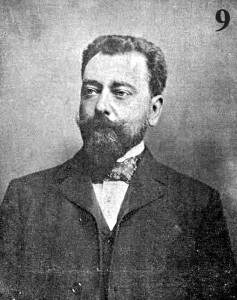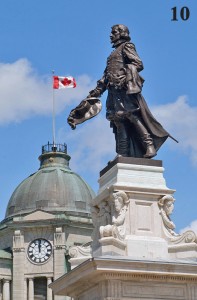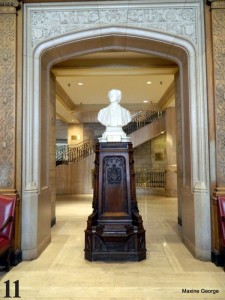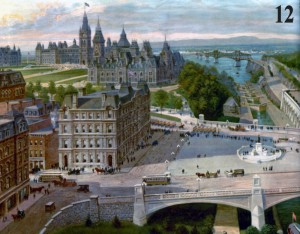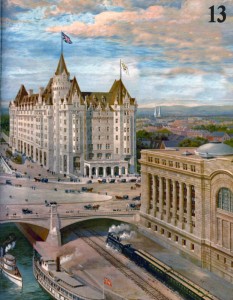Part 2 of 4: Important New Acquisition for the Toronto Railway Museum
In a remarkable coincidence, another Titanic passenger was Paul Chevré (IMAGE #9), the French sculptor who created a bust of Laurier that would grace the lobby of the Chateau Laurier. Unlike Hays, Chevré was able to get into a lifeboat and survived the disaster. Probably the sculptor’s most famous work in Canada is the Samuel de Champlain memorial on the Dufferin Terrace in Quebec City near the Chateau Frontenac Hotel. (IMAGE #10)
In deference to Hays’ death, the opening of the Chateau Laurier and Central Station was delayed until June 1, 1912. Sir Wilfred Laurier was the guest of honour that day and was reportedly enraged by the fact that the nose on his bust had been damaged. Supposedly this had occurred when Chevré had entered the lifeboat and dropped it on the floor in the confusion. In fact, the bust had been sent over on another ship and had been damaged by a clumsy hotel employee. The sculpture was subsequently repaired and can be seen in the hotel lobby. (IMAGE #11)
Interpreting the Print
IMAGE #12 is a detail from the left side of the print. The building on the upper left on Parliament Hill is the old Centre Block that was destroyed by fire in 1916 and rebuilt in subsequent years. Moving to the right is the Parliament East Block. Further to the right and in the distance is the Alexandra Interprovincial Bridge built by the Canadian Pacific Railway and connecting Ottawa and Hull, Quebec over the Ottawa River. Moving back towards the foreground are the upper locks of the Rideau Canal. The small stone building nestled in the trees left of the waterway was the Lockmaster’s Office. The plaza has several automotive and horse-drawn vehicles.
The two intersecting streets are Wellington (top) and Sparks (bottom). Marching along Wellington Street are the Governor General’s Foot Guards on parade.The most prominent nearer building is the old (1876) Central Post Office, which was demolished in 1938 to eventually make way for Jacques Gréber’s redesign of what is now called Confederation Square, which includes the contemporary National War Memorial. The memorial seen on the bridge was artistic license as the plaza was being redeveloped at the time. Trundling along Sparks Street are two electric streetcars of the Ottawa Electric Railway Company.
IMAGE #13 is the right side of the print and depicts its primary subject, the Chateau Laurier Hotel. Across the street is the Grand Trunk Central Station, connected to the hotel by a tunnel. Most of the tracks and the train shed are out of view on the right. The two visible tracks lead to the Interprovincial bridge seen in the previous view. In actual practice, the Grand Trunk train depicted would not have used these tracks. The tracks were used by the Canadian Pacific Railway, including the Montreal-Vancouver transcontinental flagship, The Canadian. The bridge was also used by an inter-city streetcar system, the Hull Electric Co. that terminated in a loop under the hotel until 1948. The larger steamship in the canal is the Rideau Queen.
Much has changed in the past 100 years. The hotel was expanded from 300 to 500 rooms in 1929. Central Station became Union Station in 1920 and was used by the GTR, CPR and the New York Central Railroad. The station closed in 1966 after a new station was built two miles away. The building is now the Government Conference Centre and is normally not open to the public except during the annual Doors Open event. There are no railway tracks remaining in downtown Ottawa.
Click here to read Part 3 in this series of TRHA Postings.
Posting by Derek Boles, Toronto Railway Historical Association Historian
Click on each image below for a closer look!


